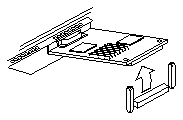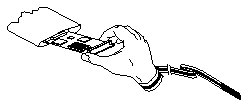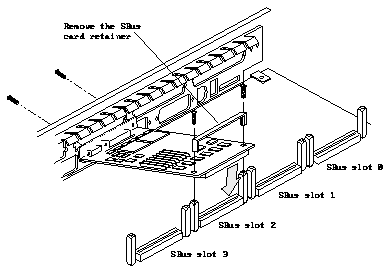
Make sure that only qualified personnel perform this installation procedure.
Follow the instructions to verify the version of the operating system that is
installed, unpack the shipment, and install the SBus card on the 600MP system
board.
This chapter refers to installation procedures for SPARCsystem 600MP series
products. If you intend to install the SBE/S card in another system, check with
your Sun sales person to first determine that the other system supports SBE/S.
If so, follow the SBus installation procedure shipped with that system.
The SBE/S SBus card is designed for installation in systems that are running
SunOS Version 4.1.2 or later, Solaris 2.x, or another compatible operating
system. If you have any doubts about the version you are running, execute the
command that identifies the operating system and its version number, as
appropriate for your system:
1. Go to the handbook that came with your peripheral to find this UNIX
command.
2. See the section about verifying the system environment.
3. Return to this book after you execute the command.
If the system is not running a compatible operating system, you must install
one before you can continue.
1. Remove the components from the packing box. In addition to this guide,
the shipment should include:
a.
An anti-static bag containing the SBE/S SBus card and the cables.
b.
An electro-static discharge (ESD) kit.
2. Save the packing box and packing materials in case you need to transport
the card.
Do not open the bag containing the SBus card until you are instructed to do so.
The SBE/S SBus card can be installed in any SBus slot on the system board.
Electrostatic Discharge Precautions

Caution - Circuit board components are vulnerable to damage by electrostatic
discharge (ESD). An electrostatic charge can build up on the human body and
then discharge when you touch a board. Such discharge can be produced by
walking across a carpet and touching a board, or by other similar causes. Before
handling any board, make sure you dissipate your body's charge. Touch a
conductive surface of the chassis or other element connected to common earth
ground to discharge the static electricity present in your body. To minimize risk
of ESD damage:
o Handle board by edges only.
o Store board in antistatic bag provided.
Use Sun ESD kit P/N 250-1088 (or equivalent) when working on the 600MP
System Board or the 600MP Expansion Memory Board. Sun ESD kit P/N 250-
1088 contains the Sun approved Sun ESD mat which has 0.25" of cushioning to
protect underside components, prevent board flexing, and provide ESD
protection. Instructions for use are printed on the mat.
Do NOT use ESD kit P/N 560-1302 when installing SPARCsystem 600MP
boards. ESD kit P/N 560-1302 does not provide adequate protection for
SPARCsystem 600MP boards.
Caution -

Make sure that the springfingers on the PC board are not shorted
against any ungrounded part of the SBus card. Shorting active components to
the springfingers can cause severe damage to the SBus card and/or the system.
In some SBus card installations, the SBus cards are mounted close to the
springfingers. If the springfingers only make contact with a grounded
connector shell on the SBus card, no insulator shield is required. Otherwise,
inspect the space between the springfingers and components on the SBus card.
Remember that the springfingers may be compressed (that is, closer to the
SBus card) when the system board is installed. If there is any possibility of
contact, install an insulating shield on the SBus card.
Note -
The installation instructions in this document are specific for installing
SBus cards in SPARCsystem 600MP systems. If you are installing SBus cards in
other Sun systems, refer to the installation instructions provided with the
system.
Before turning off the system power, you must halt the operating system:
1. Go to the handbook that came with your peripheral to find this procedure.
2. See the section about shutting down the system.
3. Return to this book after you perform the procedure.
4. After the system has halted, use the power switch to turn off the system
power.
Caution -

Turn off the power at the main AC breaker on the rear of the system
before you insert or remove boards and disk drives. Then, turn off the main
power at the switch on the power supply. Do not disconnect the AC power
cord from its receptacle.
Caution -

Use Sun ESD kit P/N 250-1088 (or equivalent) when installing
integrated circuits, printed circuit boards, and drives in a SPARCsystem
600MP. Follow the instructions printed on the ESD mat. Refer to the section,
"Electrostatic Discharge Precautions" for a description of the ESD mat.
Do NOT use ESD kit P/N 560-1302 when working on SPARCsystem 600MP
boards.
1. Move the system so that you have easy access to the enclosure.
2. Spread an anti-static mat, P/N 250-1088, in the area where you are
working.
3. If the system is a 56-Inch Data Center Cabinet, use a #2 phillips
screwdriver to remove the vented, rear panel. Then, go to step 6.
4. If the system is a 12-Slot Office Pedestal, go to step 6.
5. If the system is a 5-Slot Office Pedestal, remove the top cover:
a. Locate the top cover release knob. Turn the knob counter-clockwise a
1/4-turn or until you hear a click.
b. Slide the top cover back and lift the cover off of the chassis. Set the
cover aside.
6. Label the cables, including the cables that are attached to serial ports A
and B and any cables that are connected to any SBus cards. Then, remove
all of the cables.
7. Use a 2 mm hexagonal allen wrench to remove the hex-socket cap screws
that are located at each end of the system board. Set the four screws aside.
8. Move the extraction levers on the system board outward to release the
board from the backplane connectors.
9. Gently remove the system board from the enclosure.
If you need to remove or replace an SBus card, follow these steps.
Caution -

Do not bend or press on the SBus card when you are removing it
from the system board.
1. Use a flat blade screwdriver to remove the top slotted screws from the
standoffs that are located on both sides of the SBus connector.
2. Use a phillips screwdriver or a flat blade screwdriver to remove the two
screws that attach the SBus card to the CPU backplate.
3. Hold the board by the edges that are closest to the connector.
4. Gently rock the card back and forth to loosen the card from the connector.
5. Lift the SBus card off of the connector at an angle. See Figure 2-1.

Figure 2-1
Removing an SBus Card from the System Board
6. Guide the faceplate of the SBus card out of the back panel opening.
7. If you are not installing an SBus card in the slot, install a filler plate on
the back panel opening. Then, replace the cables.
Note -
The SBus card uses different screws than the filler plate. To install a
filler, use the screws that originally attached the filler plate, or obtain M2.5
screws.
Follow the instructions in this section to set the jumper on the SBus card and
install the card on the system board.
Setting the J0302 Jumper
Before you install the SBus card, you need to set the J0302 jumper. J0302 is a
two header jumper that uses a two-pin shunt. Follow these steps to set the
J0302 jumper.
1. Remove the SBus card from the bag. See Figure 2-2.

Figure 2-2
Handling the SBE/S SBus Card
2. Spread the bag on a firm surface and use it as a protective mat.
3. Place the SBus card, component side-up, on the bag.
4. Locate the J0302 jumper on the SBus card. See Figure 2-3.

Figure 2-3
SBE/S SBus Card Components
5. Configure the jumper:
a. Use needle-nose pliers and put the shunt over both pins on the jumper
to select thick Ethernet. See Figure 2-4.
b. Use needlenose-pliers and put the shunt in one pin of the jumper to
select the twisted-pair interface port. See Figure 2-4.

Figure 2-4
Selecting Between Thick (AUI) Ethernet and Twisted-Pair Ports
Installing the SBus Card on the System Board
Up to four SBus cards can be installed on the system board. If two SPARC
modules are installed, only three SBus slots are available.
Follow these steps to install the SBus card.
Caution -

Handle the SBus card with care. Handle the card only by the edges.
Caution -

Do not bend or press on the SBus card during installation on the
system board.
1. If there is a filler plate installed in the SBus slot on the back panel of the
CPU, use a # 1 phillips screwdriver and remove the two phillips flat-head
screws that secure the filler plate to the back panel. See Figure 2-5.
Discard the screws and the filler plate.

Figure 2-5
600MP System Board Rear Panel
2. Remove the black retainer handle from the SBus card. Discard the
retainer.
3. Use a flat blade screwdriver to remove the two, slotted screws from the
top of the standoffs on both sides of the SBus connector on the system
board.
4. Use a #1 phillips screwdriver and remove the top two screws that attach
the adapter bracket to the SBE/S back panel. Discard the adapter and the
screws. See Figure 2-6.
5. Use a #1 phillips screwdriver to remove the black screw on the left side of
the SCSI connector. See Figure 2-6. Use a #1 phillips screwdriver to
remove the lower screw on the right side of the Ethernet connector. Save
the screws.

Figure 2-6
SBE/S SBus Card Back Panel
6. Carefully guide the SBus card faceplate under the springfingers. Move it
against the rear face of the CPU back panel. The I/O connectors on the
back panel of the SBus card should stick out through the opening in the
CPU back panel. See Figure 2-7.

Figure 2-7
Installing the SBus Card on the Connectors
7. Check the alignment of the connector before you seat the card. If
necessary, align the card by gently pushing the card towards the back
panel.
8. Rotate the card downward until the connector on the card is aligned with
the connector on the system board.
9. Gently press the SBus card onto the connector until the card is firmly
seated.
10. Use a #1 phillips screwdriver to replace the screw from the SCSI
connector. Use a #1 phillips screwdriver to replace the screw from the
Ethernet connector. Thread the screws through the CPU and SBus back
panel and into the appropriate connector. See Figure 2-8.

Figure 2-8
SBE/S SBus Card Back Panel Assembly
11. Replace and tighten the two slotted screws with a flat blade screwdriver to
secure the SBus card to the system board. Use the screw holes that were
used to hold the retainer to the SBus card.
Follow these steps to install the system board in the enclosure:
1. Move the extraction levers on the system board to the closed position.
2. Gently replace the board in the enclosure.
3. Make sure the board connectors are firmly seated against the connectors
on the cardcage.
4. Use a 2 mm hexagonal allen wrench and replace the hex socket cap screws
that secure the board to the cardcage.
5. If the system is a 56-Inch Data Center Cabinet, use a #1 phillips
screwdriver and replace the two screws that secure the vented rear panel
to the enclosure. Then, go to step 8.
6. If the system is a 12-Slot Office Pedestal, go to step 8.
7. If the system is a 5-Slot Office Pedestal, replace the top cover:
a. Slide the cover towards the front of the system until the tabs mate with
the retaining slots at the front and rear of the system.
b. Secure the top cover by turning the release knob clockwise a 1/4-turn
or until you hear a click.
8. Move the system to its normal operating location.
9. Remove and store the anti-static mat.
Cabling the SBus Card
Note -
Ensure that termination is provided for the last device in a chain of
SCSI devices.
These cables and connectors are provided with the SBus card:
-
14-pin champ to 15-pin Ethernet adapter
-
14-pin champ to 8-pin RJ45 Ethernet adapter
Follow these steps to replace the cables, cable the SCSI and select AUI or
twisted-pair Ethernet.
1. Replace the cables that you labeled and removed.
2. Connect the SCSI connector cable to the SCSI receptacle.
Note -
Make sure that you select cables that match the setting of the J0302
jumper (see Figure 2-4).
3. If you want thick Ethernet, use the 14-pin to 15-pin adapter cable:
a. Connect the 14-pin champ adapter cable connector to the Ethernet port.
b. Open the slide-lock and connect a standard 15-pin Ethernet transceiver
cable to the adapter cable.
4. If you want twisted-pair interface, use the 14-pin to RJ45 adapter cable:
a. Connect the 14-pin champ connector end of the adapter cable into the
Ethernet port.
b. Connect the 8-pin, 10 Base-T connector to the 8-pin end of the TP
adapter cable.
Follow these steps to power-up the system:
1. Set the power switch on the chassis to the ON position.
2. Wait for the system to boot.
If you need help with booting:
a. Go to the handbook for your system's operating system that came with
the peripheral to find this procedure.
b. See the section about booting the system.
c. Return to this book after you perform the procedure.
Note -
If your system is running SunOS Version 4.x, and you plan to install
devices on the SCSI bus that do not have a device name allocated for them in
the GENERIC file, you need to configure a kernel. See Appendix B.



